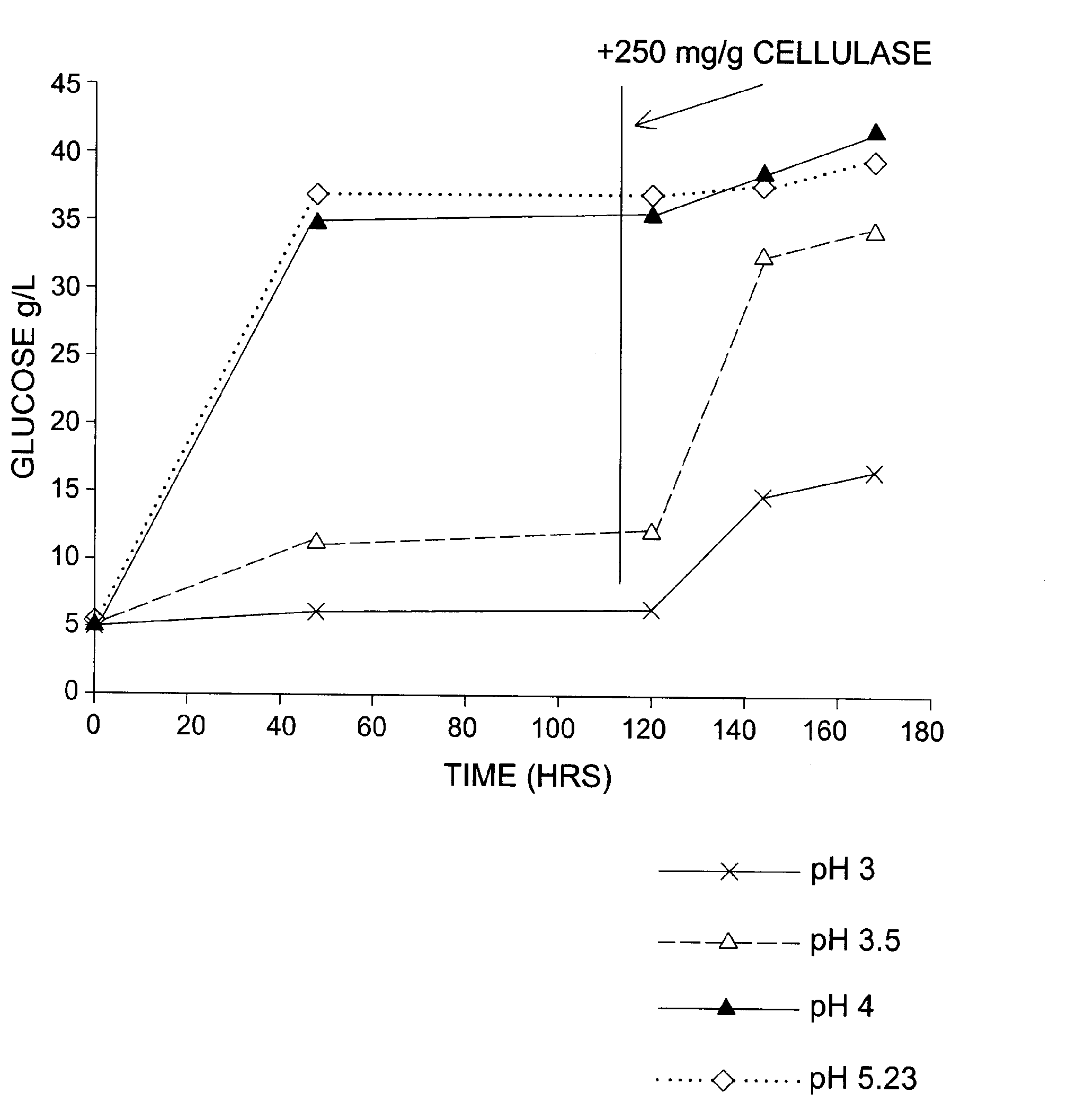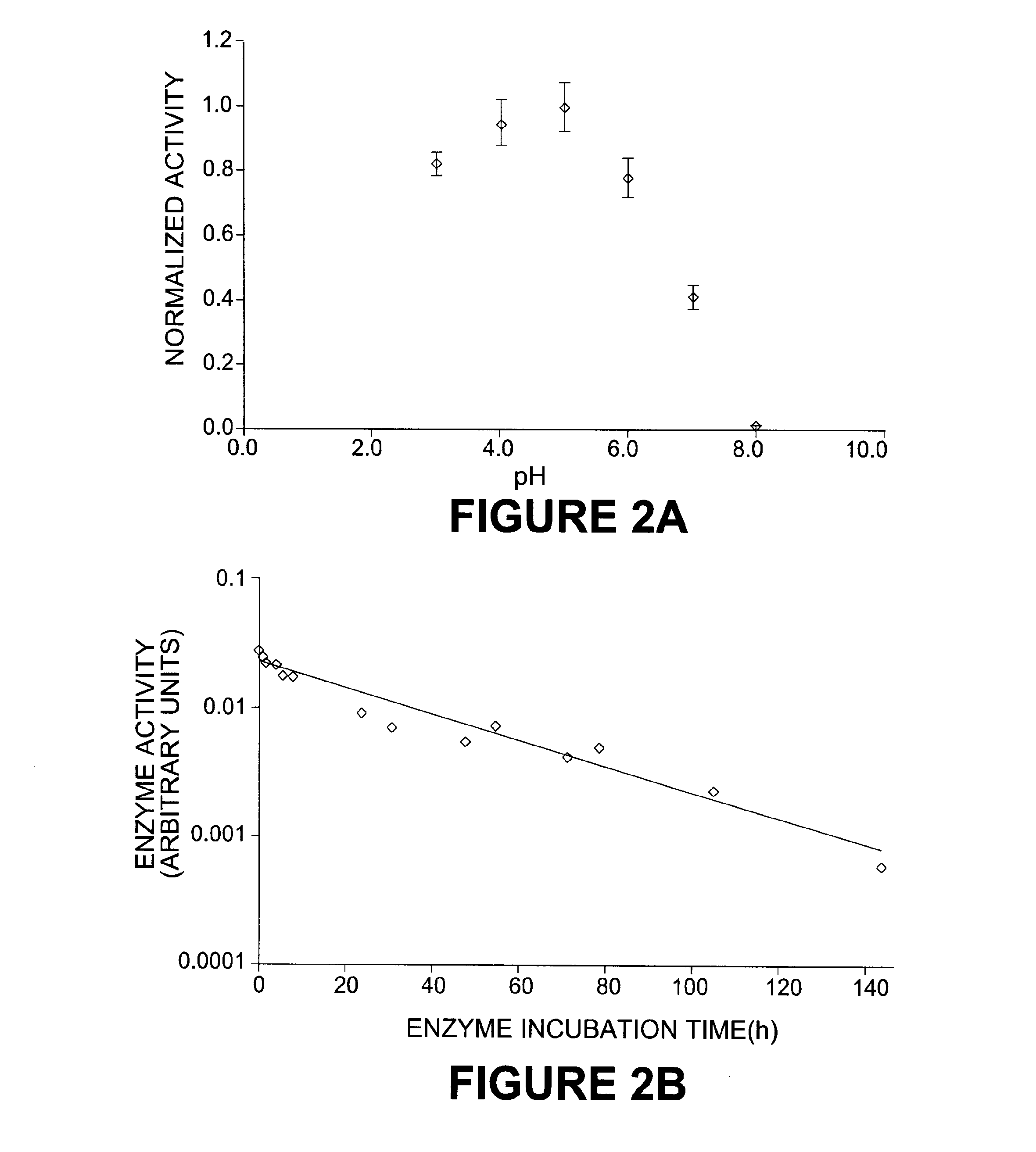Method for the production of a fermentation product from lignocellulosic feedstocks
a technology of lignocellulosic feedstock and fermentation product, which is applied in the direction of fermentation, biofuels, etc., can solve the problems of only a limited impact of processes on reducing greenhouse gases, the limitation of feedstocks already used as food sources, and the inability to reduce so as to improve the yield of xylose, reduce the cost, and improve the effect of process efficiency
- Summary
- Abstract
- Description
- Claims
- Application Information
AI Technical Summary
Benefits of technology
Problems solved by technology
Method used
Image
Examples
example 1
Comparative Example Showing the Acid and Alkali Demand of Conventional Processes to Produce Ethanol Verses a Process of the Present Invention
[0094]FIG. 1A shows the minimum and maximum pH of lignocellulosic feedstocks used to produce ethanol as well as the pH values that are conventionally employed in each stage of a process employing acid pretreatment, enzymatic hydrolysis, fermentation and distillation.
[0095]As shown in the conventional process of FIG. 1A, the pH of the incoming lignocellulosic feedstock is between about 6.0 and 8.0. The pH of the feedstock then is decreased with acid, such as sulfuric acid, to a pH between about 0.5 and 2.0. Acid pretreatment is then conducted at a temperature and for a time sufficient to hydrolyze the hemicellulose component of the feedstock with limited hydrolysis of cellulose. Alkali is subsequently added to the acidic, pretreated feedstock to achieve a pH in the range of 4.5 to 5.5 for cellulase enzymes. Enzymatic hydrolysis of the pretreated...
example 2
The Activity and Stability of Trichoderma Cellulase at Reduced pH
[0100]Wheat straw was pretreated using dilute acid steam explosion (U.S. Pat. No. 4,461,648, which is incorporated herein by reference) and delignified using hypochlorite bleaching and caustic extraction. The delignified material was slurried in water to a final concentration of 1.8 g cellulose / L and homogenized with a rotor-stator homogenizer. It was then degassed under vacuum for 5 minutes with constant stirring prior to use in the assay.
[0101]The slurry was further diluted to 0.6 g / L cellulose using concentrated citrate-phosphate buffer having a working buffer concentration of 50 mM. Samples were prepared in methacrylate cuvettes to a final volume of 3 mL. Samples were prepared over the pH range of 3.0 to 8.0 in increments of 1 pH unit. The absorbance of each slurry at 600 nm and 50° C. was monitored in a Cary300 spectrophotometer (Varian) with a temperature-controlled heating block. Samples were first incubated and...
example 3
Enzymatic Hydrolysis of Pretreated Feedstock with Trichoderma Cellulase at Reduced pH
[0104]Wheat straw was pretreated using dilute acid steam explosion (U.S. Pat. No. 4,461,648, which is incorporated herein by reference). The resulting pretreated feedstock solids contained 46.2% cellulose and the slurry of pretreated wheat straw contained 7.35% undissolved solids (% UDS). For each assay, 70 grams of slurry was adjusted to the target pH with a 15 wt % NaOH solution. Cellulase was added to the slurry at a dosage of 25 mg of cellulase per gram of cellulose (mg / g) and the mixture incubated at 50° C. with orbital shaking at 250 rpm for 120 hours. Samples (500 μL) were removed at selected time points, boiled for 10 minutes to deactivate the cellulase, and then stored at 4° C. for later analysis. After 120 hours, an additional 250 mg cellulase per gram of cellulose was added to the assay flasks and the hydrolysis was continued for a total of 168 hrs.
[0105]In a second series of assays, cell...
PUM
| Property | Measurement | Unit |
|---|---|---|
| Temperature | aaaaa | aaaaa |
| Temperature | aaaaa | aaaaa |
| Percent by mass | aaaaa | aaaaa |
Abstract
Description
Claims
Application Information
 Login to view more
Login to view more - R&D Engineer
- R&D Manager
- IP Professional
- Industry Leading Data Capabilities
- Powerful AI technology
- Patent DNA Extraction
Browse by: Latest US Patents, China's latest patents, Technical Efficacy Thesaurus, Application Domain, Technology Topic.
© 2024 PatSnap. All rights reserved.Legal|Privacy policy|Modern Slavery Act Transparency Statement|Sitemap



